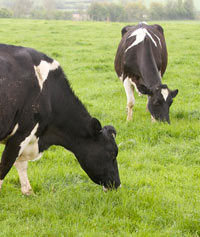Get more from your grassland with GrassWatch

Grassland must be managed with extra care this year as pastures play catch-up after a long and cold winter.
Beef and sheep farmers in particular have much to gain from bringing their grazing under control, says EBLEX.
“Sucklers and sheep tend to be pushed towards marginal grazing and sward management gets less attention,” says EBLEX scientist Liz Genever.
“The result is greater cost from bought-in feeds and conserving more forage. Poor quality grazing also leads to higher methane production, so there’s a strong environmental driver, too.”
The key to improving sward productivity is to monitor its performance. That’s why EBLEX, in association with Farmers Weekly, has launched a major initiative to help beef and sheep farmers get better value from their grassland.
Throughout the season GrassWatch is monitoring grass growth at eight college farms across England, with the results posted fortnightly on FWi.
A Grasswatch blog will be posting regular commentary on grass growth from experts and producers.
Beef and sheep farmers are encouraged to log on to GrassWatch regularly throughout the season. An interactive map displays the ten colleges across England taking part in the monitoring programme.
Farmers should pick a location near them to see graphs displaying grass growth rate, total cover and digestibility. These offer a benchmark of the kind of grass growth producers can expect, says Dr Genever.
“The colleges have chosen good, bad and average sites, which include new re-seeds and environmental grazing. Whatever your farming system you should find there are sites applicable to your situation.
“As the year progresses, we’re hoping GrassWatch will demonstrate the potential that often lies untapped in England’s pastures.”
The quirks of the weather this year mean careful management will be essential to get the maximum value out of your grassland, notes the GrassMaster, independent grazing expert Charlie Morgan.
“The long winter means early spring growth has been delayed,” he explains.
“But as soon as soil temperatures at a depth of 10cm consistently reach at least 5C, grass growth will sprint away.
“If you lose control in the spring and don’t keep stock numbers correct once the grass starts to grow, you will lose D-value, lose performance and pile on extra costs through topping or mowing pasture to keep it in good condition.”
The management you apply in the first third of the season will dictate the quality of your sward for the remaining two-thirds, advises Mr Morgan.
“Utilisation is king – that keeps the quality of the grass cover high and your cost of production low.”
The aim should be to maintain grass cover of around 4-6cm for sheep and 8-10cm for cattle that are set stocked.
If grass yield exceeds these targets, the quality of the grass will reduce and it will be more difficult for your stock to graze it cleanly.
“The key is to anticipate your grass growth – get the information you need ahead of when you will be moving your stock by using a sward stick or marks on your welly.
“Otherwise, by the time you’ve adjusted your stocking density, the grass will have gone to stem and it will be too late.”
There are two key assessments: Grass cover, measured in kg of dry matter per ha, and Sward quality –D value indicates its digestibility.
Although you can estimate grass cover by how high the grass comes up your boot, a rising plate meter gives a far more accurate measurement.
“A plate meter indicates sward density by measuring compressed sward height,” notes Mr Morgan.
Keep accurate records of fertiliser, slurry and manure applications and soil analysis results, he adds.
Once you start to record the performance of your sward, you can not only optimise its grazing potential within the season, but take steps to improve its future productivity.
“You need to invest time and financial resources, but it pays dividends – grass will always be a quarter of the price of concentrates. Improve your sward performance and you will drastically cut your feed bill.”
• Charlie Morgan will be posting commentary on grass growth throughout the season, as part of the GrassWatch initiative. He will be joined by a number of producers who took part in an EBLEX pilot study into grass growth last year.
• Case study 1 – Buckinghamshire
• Case study 2 – Cumbria
